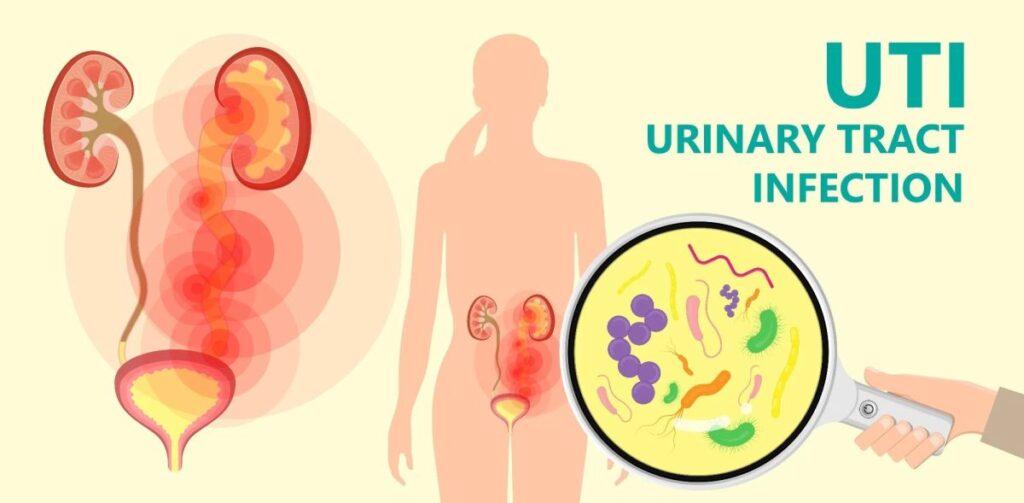Urinary Tract Infections are infections in any part of the urinary system, the kidneys, bladder or urethra.
Table of Contents
ToggleCOMMON TERMS IN URINARY SYSTEM
- Proteinuria
Daily excretion of proteins in the urine more than 150mg. It signifies that the kidney is damaged/ perforated. - Haematuria
Means passing urine containing blood and is due to bleeding into the urinary tract. - Crystaluria
Presence of crystals like oxalates, phosphates in the urine detected by microscopic examination of urine - Glycosuria
Means presence of sugar (glucose) in urine either due to diabetes mellitus or due to renal glycosuria - Azotenia
Increase in the serum concentration of urea and creatinine above their normal values.
This occurs when glomerular filtration pressure (GFR) of the kidneys falls due to renal failure. “uremia”. - Oliguria
Diminished urine volume output of urine i.e. >100mls per 2 hours. - Anuria – Complete absence of urine formation
- Dysuria – Difficulty or pain in passing urine
- Polyuria – Urine volume above 3 litres per day
- Retention of urine – occurs due to obstruction of urine outflow from the bladder, this is relieved by catheterization
Introduction to Urinary Tract Infections
The lower urinary tract consists of the bladder and the urethra. Infection in the lower urinary tract can affect the urethra (urethritis) or the bladder (cystitis) or prostate gland (prostatitis)
Infection in the upper urinary tract are called upper urinary tract infections (UUTI’s) and includes pyelitis and nephritis/ pyelonephritis
Causes of Urinary Tract Infections
- E.coli
- Group B streptococci
- Klebsiella pneumoniae
- Proteus species
- Enterobacter species
- Enterococcus species
- Staphylococcus
People at risk of urinary tract infection
- People with conditions that block (obstruct) the urinary tract, such as kidney stones.
- People with medical conditions that cause incomplete bladder emptying (for example, spinal cord injury or bladder decomposition after menopause)
- People with suppressed immune systems: Examples of situations in which the immune
system is suppressed are HIV/AIDS and Diabetes. People who take immunosuppressant
medications such as chemotherapy for cancer are also at high risk. - Women who are sexually active: Sexual intercourse can introduce larger numbers of bacteria into the bladder. Urinating after intercourse seems to decrease the likelihood of developing a urinary tract infection.
- Women who use a diaphragm for birth control.
- Men with an enlarged prostate: Prostatitis or obstruction of the urethra by an enlarged prostate can lead to incomplete bladder emptying, thus increasing the risk of infection. This is most common in older men.
- NB Males are less likely to develop UTIs because their urethra (tube from the bladder) is longer. There is a drier environment where a man’s urethra meets the outside world, and fluid
produced in the prostate can fight bacteria
ACUTE PYELONEPHRITIS
This is characterized by acute inflammation of the parenchyma(core substance of the kidney/kidney tissue) and the pelvis of the kidneys. The disease may be bilateral or unilateral.
This usually results from untreated bacterial cystitis and may be associated with pregnancy, trauma of the urinary bladder, and urinary obstruction
Cause of pyelonephritis
- Klebsiella pneumoniae
- Proteus
- E-coli and E. faecalis
- Streptococcus albus and streptococcus epidermidis
- Pseudomonas
Clinical presentation of pyelonephritis
- Sudden pain on both loin and one loin radiating to the iliac fossa and suprapubic area.
- Dysuria
- Frequent passage of small amounts of urine (scalding and cloudy urine)
- Strangury – painful desire to pass urine though the bladder is empty.
- Fever (temp raise to 38 – 40 degrees) with rigors.
- Vomiting and nausea
- Tenderness over the renal angle with muscle guarding
- High white blood cells count
- Protein, pus and heavy growth of bacteria in urine.
- Diarrhea and convulsion especially in children
NB: this disease can progress to renal failure if not treated.
Differential diagnosis of pyelonephritis
- Appendicitis
- Salpingitis
- Cholecystitis
Investigations of pyelonephritis
- Urine microscopy for pus cells and micro-organism and proteins (obtain midstream urine)
- Intravenous urography to rule out renal abscess
- Blood for DLC (differential leukocyte count) and TLC (total leukocyte count) shows leukocytosis with neutrophilia and raised ESR(Erythrocyte Sedimentation Rate)
- Ultra sound scans to locate obstruction in the urinary tract
- Blood for urea and electrolyte estimation
Management of pyelonephritis
- Complete bed rest must be ensured
- Patients should drink adequate fluids about 3 litres (atleast 8 glasses of fluids) daily.
- Fluid input & urinary output monitoring to assess kidney function
- Anti-inflammatory therapy e.g. NSAIDS and anti emetics
Ampicillin IV 1g 4-6 hrs for 14/7 plus gentamycin 2.5mg/kg iv/im 8 hourly for 7 days
Or
Cotrimoxazole and aminoglycosides are effective
Or amoxicillin 500mg tds for 10-14 days - Ensure perianal hygiene and ensure complete emptying of the bladder
- Daily weighing-to determine adequate hydration and any abnormal increase in weight must be reported
Chronic pyelonephritis
This occurs due vesicoureteral reflux ( back flow of urine from the bladder to the ureters allowing spread of infection upwards to the kidneys. The condition is also called reflux nephropathy
Progressive damage of renal papillae and collecting ducts led to renal failure and hypertension. congenital abnormality on the insertion of ureters to the bladder predispose to the condition. It leads to small kidney, scaring of the kidneys and clubbing of the calyces.
It clinical presents with bacteriuria, hypertension, flunk tenderness, septic shock, dizziness fainting and signs of renal insuficiency



Thanks alot
It’s so so wonderful to read on this platform so try to add some details of nursing process and differential diagnosis.
Notice about nurse patient relationship
Great book it has helped me during my course of study but If I want to download it what can I do
Easy to read And understand
This is so wonderful thank you so much